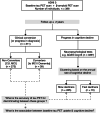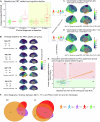Tau PET positivity predicts clinically relevant cognitive decline driven by Alzheimer's disease compared to comorbid cases; proof of concept in the ADNI study
- PMID: 39179903
- PMCID: PMC11746147
- DOI: 10.1038/s41380-024-02672-9
Tau PET positivity predicts clinically relevant cognitive decline driven by Alzheimer's disease compared to comorbid cases; proof of concept in the ADNI study
Abstract
β-amyloid (Aβ) pathology is not always coupled with Alzheimer's disease (AD) relevant cognitive decline. We assessed the accuracy of tau PET to identify Aβ(+) individuals who show prospective disease progression. 396 cognitively unimpaired and impaired individuals with baseline Aβ and tau PET and a follow-up of ≥ 2 years were selected from the Alzheimer's Disease Neuroimaging Initiative dataset. The participants were dichotomously grouped based on either clinical conversion (i.e., change of diagnosis) or cognitive deterioration (fast (FDs) vs. slow decliners (SDs)) using data-driven clustering of the individual annual rates of cognitive decline. To assess cognitive decline in individuals with isolated Aβ(+) or absence of both Aβ and tau (T) pathologies, we investigated the prevalence of non-AD comorbidities and FDG PET hypometabolism patterns suggestive of AD. Baseline tau PET uptake was higher in Aβ(+)FDs than in Aβ(-)FD/SDs and Aβ(+)SDs, independently of baseline cognitive status. Baseline tau PET uptake identified MCI Aβ(+) Converters and Aβ(+)FDs with an area under the curve of 0.85 and 0.87 (composite temporal region of interest) respectively, and was linearly related to the annual rate of cognitive decline in Aβ(+) individuals. The T(+) individuals constituted largely a subgroup of those being Aβ(+) and those clustered as FDs. The most common biomarker profiles in FDs (n = 70) were Aβ(+)T(+) (n = 34, 49%) and Aβ(+)T(-) (n = 19, 27%). Baseline Aβ load was higher in Aβ(+)T(+)FDs (M = 83.03 ± 31.42CL) than in Aβ(+)T(-)FDs (M = 63.67 ± 26.75CL) (p-value = 0.038). Depression diagnosis was more prevalent in Aβ(+)T(-)FDs compared to Aβ(+)T(+)FDs (47% vs. 15%, p-value = 0.021), as were FDG PET hypometabolism pattern not suggestive of AD (86% vs. 50%, p-value = 0.039). Our findings suggest that high tau PET uptake is coupled with both Aβ pathology and accelerated cognitive decline. In cases of isolated Aβ(+), cognitive decline may be associated with changes within the AD spectrum in a multi-morbidity context, i.e., mixed AD.
© 2024. The Author(s).
Conflict of interest statement
Competing interests: The authors declare no competing interests. Consortia: Data used in preparation of this article were obtained from the Alzheimer’s Disease Neuroimaging Initiative (ADNI) database ( adni.loni.usc.edu ). As such, the investigators within the ADNI contributed to the design and implementation of ADNI and/or provided data but did not participate in analysis or writing of this report. A complete listing of ADNI investigators can be found at: https://adni.loni.usc.edu/wp-content/uploads/how_to_apply/ADNI_Acknowledgement_List.pdf .
Figures





Similar articles
-
Amyloid and Tau Prediction of Cognitive and Functional Decline in Unimpaired Older Individuals: Longitudinal Data from the A4 and LEARN Studies.J Prev Alzheimers Dis. 2024;11(4):802-813. doi: 10.14283/jpad.2024.122. J Prev Alzheimers Dis. 2024. PMID: 39044488 Free PMC article. Clinical Trial.
-
Alpha synuclein co-pathology is associated with accelerated amyloid-driven tau accumulation in Alzheimer's disease.Mol Neurodegener. 2025 Mar 18;20(1):31. doi: 10.1186/s13024-025-00822-3. Mol Neurodegener. 2025. PMID: 40098057 Free PMC article.
-
Synergistic associations of amyloid-β and phosphorylated tau with tau aggregation and cognitive decline in Alzheimer's disease.J Alzheimers Dis. 2025 Apr;104(4):1036-1044. doi: 10.1177/13872877251322196. Epub 2025 Mar 17. J Alzheimers Dis. 2025. PMID: 40091557
-
Understanding disease progression and improving Alzheimer's disease clinical trials: Recent highlights from the Alzheimer's Disease Neuroimaging Initiative.Alzheimers Dement. 2019 Jan;15(1):106-152. doi: 10.1016/j.jalz.2018.08.005. Epub 2018 Oct 13. Alzheimers Dement. 2019. PMID: 30321505 Review.
-
Recent publications from the Alzheimer's Disease Neuroimaging Initiative: Reviewing progress toward improved AD clinical trials.Alzheimers Dement. 2017 Apr;13(4):e1-e85. doi: 10.1016/j.jalz.2016.11.007. Epub 2017 Mar 22. Alzheimers Dement. 2017. PMID: 28342697 Free PMC article. Review.
Cited by
-
Return of research results across the Alzheimer's Disease Research Centers network.Alzheimers Dement. 2025 Jun;21(6):e70418. doi: 10.1002/alz.70418. Alzheimers Dement. 2025. PMID: 40545555 Free PMC article.
-
Early Alzheimer's Disease with frequent neuritic plaques harbors neocortical tau seeds distinct from primary age-related tauopathy.Nat Commun. 2025 Feb 21;16(1):1851. doi: 10.1038/s41467-025-56469-7. Nat Commun. 2025. PMID: 39984462 Free PMC article.
-
Evaluation of the Revised Criteria for Biological and Clinical Staging of Alzheimer Disease.JAMA Neurol. 2025 Jul 1;82(7):666-675. doi: 10.1001/jamaneurol.2025.1100. JAMA Neurol. 2025. PMID: 40388185 Free PMC article.
-
Repeated plasma p-tau217 measurements to monitor clinical progression heterogeneity.Alzheimers Dement. 2025 May;21(5):e70319. doi: 10.1002/alz.70319. Alzheimers Dement. 2025. PMID: 40442871 Free PMC article.
-
Integrating visual assessments and quantification methods for tau PET staging.Alzheimers Dement. 2025 Jun;21(6):e70352. doi: 10.1002/alz.70352. Alzheimers Dement. 2025. PMID: 40545562 Free PMC article.
References
-
- Kadir A, Marutle A, Gonzalez D, Schöll M, Almkvist O, Mousavi M, et al. Positron emission tomography imaging and clinical progression in relation to molecular pathology in the first Pittsburgh Compound B positron emission tomography patient with Alzheimer’s disease. Brain. 2011;134:301–17. - PMC - PubMed
-
- Rowe CC, Bourgeat P, Ellis KA, Brown B, Lim YY, Mulligan R, et al. Predicting Alzheimer disease with β-amyloid imaging: results from the Australian imaging, biomarkers, and lifestyle study of ageing. Ann Neurol. 2013;74:905–13. - PubMed
-
- Sabri O, Sabbagh MN, Seibyl J, Barthel H, Akatsu H, Ouchi Y, et al. Florbetaben PET imaging to detect amyloid beta plaques in Alzheimer’s disease: Phase 3 study. Alzheimer’s & Dementia. 2015;11:964–74. - PubMed
MeSH terms
Substances
Grants and funding
LinkOut - more resources
Full Text Sources
Medical

